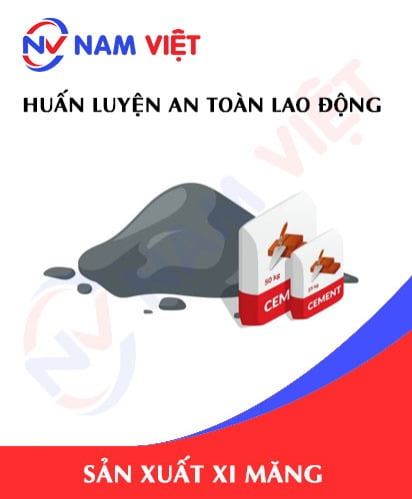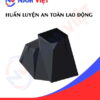Occupational Safety Training in Cement Production Factory
99,000 ₫
Note: The above price is calculated for one person and may fluctuate depending on the number of trainees participating in the course and market movements. For more accurate pricing support, please refer to the quotation table or contact our consulting staff directly.
Occupational safety is a critical issue in cement production factories and must be addressed promptly to ensure the health and safety of workers and enhance the reputation of businesses. The Occupational Safety Training course is an effective solution to raise awareness among workers on accident prevention when participating in cement production.
Table of Contents
Toggle1. Overview of Cement
a. What is cement?
- Cement is a building material used to bind various building materials into a sturdy structure. It is produced by melting the main raw materials, clay and limestone, at a very high temperature to create clinker. The clinker is then ground into a fine powder and mixed with additives such as gypsum and clay to create cement.
- Cement is widely used in the construction of various projects, from houses, buildings, and bridges to large-scale structures like factories, churches, hydroelectric dams, and ports. It is used to create strong columns, beams, walls, and floors. In addition, cement is also used to produce products such as bricks, tiles, and other building materials.
- Vietnam’s cement output has grown strongly from about 30 million tons in 2010 to over 100 million tons in 2020. Currently, Vietnam has about 80 cement factories, mainly concentrated in the Northern, Central, and Southern regions.
- However, the cement manufacturing industry in Vietnam also faces some challenges, including production overload, environmental pollution, and product quality issues. To solve these problems, the Vietnamese Government has imposed stricter regulations on the cement manufacturing industry, while encouraging cement factories to use new and advanced technology to minimize negative impacts on the environment.

b. Types of cement manufacturing machinery
The types of cement manufacturing machinery include:
- Cement kiln: is equipment used to burn and produce clinker – a key component of cement. The kiln can be designed in a vertical or horizontal shape and can be fired with rock or coal.
- Cement grinder: is used to grind clinker and additives such as gypsum and clay to create cement. There are many different types of cement grinders, including ball grinders, vertical grinders, and roller mills.
- Cement mixer: is used to mix the components of cement together to create a homogeneous mixture. There are many different types of cement mixers, including concrete mixers, conveyor mixers, and continuous mixers.
- Cement packer: is used to pack cement in bags for transportation and use. There are many different types of cement packers, including semi-automatic packers and manual packers.
In addition, there are other machines used in the cement manufacturing process such as rock crushers, transporters, pipeline systems, and cement quality analysis equipment.
c. Typical cement manufacturing enterprises
Typical cement manufacturing enterprises in Vietnam include:
- Vissai Group (VICEM): is the largest enterprise in the cement manufacturing industry in Vietnam with an annual cement output of about 30 million tons. Vissai Group currently owns 10 cement factories and 4 rock grinding factories nationwide.
- Ha Tien Cement Group: is one of the leading cement manufacturing enterprises in Vietnam, with an annual cement output of about 15 million tons. Ha Tien Cement Group currently has 4 cement factories in Vietnam.
- Fico Cement Group: is one of the largest cement manufacturing enterprises in the Southern region of Vietnam, with an annual cement output of about 3 million tons. Fico Cement Group currently has 3 cement factories in the South.
- Bim Son Cement Group: is a cement manufacturing enterprise under the Vietnam Cement Corporation (VICEM), with an annual cement output of about 2 million tons. Bim Son Cement Group currently has 2 cement factories in the North.
- Song Da Cement Group: is one of the largest cement manufacturing enterprises in the Southwestern region, with an annual cement output of about 2 million tons. Song Da Cement Group currently has 2 cement factories in the West.

d. Specific jobs in a cement manufacturing factory
Group 1
- Executive director, deputy executive director, department head in a cement manufacturing factory.
Group 2
- Safety officer: manages safety in the factory, designs safety procedures, supervises and urges employees to comply with safe working procedures.
Group 3
- Operating the cement kiln: is the job of operating and supervising the clinker firing process in the cement kiln. This job requires high technical skills to adjust and monitor the temperature and firing process to ensure the output and quality of clinker meet the requirements.
- Operating the cement grinder: is the job of operating the grinder to grind clinker and additives such as gypsum and clay to create cement. This job requires technical skills to adjust the machinery and grinding process to ensure the quality of cement meets the requirements.
- Operating the cement mixer: is the job of operating the mixer to mix the components of cement together to create a homogeneous mixture. This job requires technical skills to adjust the machinery and mixing process to ensure the quality of cement meets the requirements.
- Product quality control: is the job of checking the quality of cement produced from the machines. This job requires quality control skills and the use of analytical equipment to ensure the quality of cement meets the requirements.
- Operating the cement packer: is the job of operating the packer to pack cement in bags for transportation and use. This job requires technical skills and the use of packaging equipment to ensure the quality of packaging meets the requirements.
Group 4
- Jobs in the office, serving, sales, marketing.
- Production management, quality management, human resource management, material management, financial and accounting management.
- Research and development of new products, design of product packaging.

2. Overview of occupational safety training courses for cement manufacturing
In the scope of this article, we focus on issues related to Group 3, because Group 3 is the group that directly participates in the production process and bears the highest risk of occupational safety. Learn more about other groups here
a. What is Group 3 occupational safety training?
- Occupational safety training for Group 3 consists of training sessions to equip workers with an awareness of how to prevent occupational accidents.
- The occupational safety training course will help workers recognize and prevent dangers, and limit the risk of occupational accidents while working.
REGISTER FOR OCCUPATIONAL SAFETY TRAINING SERVICE
b. Training duration
Initial safety training duration
- The total training duration is at least 24 hours, including the test time.
- 8 hours of theoretical study on the system of policies and laws on occupational health and safety
- 8 hours of theoretical study on basic knowledge of occupational health and safety
- 4 hours of theoretical study on specialized training content
- 2 hours of practical study on specialized training content
- 2 hours of theoretical testing at the end of the training course
The safety training center will distribute the time into many training sessions depending on the time arrangement for employees. But usually, there will be 6 training sessions, the course will take place over 3 days, on the condition that the manufacturing business can arrange continuous study time.
Periodic safety training duration
- Before the occupational safety card expires, if workers want to get a new one, they must undergo a periodic occupational safety training course, with a periodic safety training duration of at least 50% of the initial safety training duration.
Explanation: the total duration of periodic occupational safety training is at least 12 hours, including the test time. After completing the periodic training course and passing the test, workers will be re-issued or have their occupational safety card renewed.
c. Content of the training course
| No. | TRAINING CONTENT | TRAINING DURATION (HOURS) | |||
| Total | Of which | ||||
| Theory | Practice | Test | |||
| I | System of policies and laws on occupational health and safety | 8 | 8 | 0 | 0 |
| 1 | Overview of the system of legal documents on occupational health and safety. | 6 | 6 | ||
| 2 | System of occupational health and safety technical standards and regulations. | 1 | 1 | ||
| 3 | Specific regulations of state management agencies on occupational health and safety when building new, expanding or renovating works, facilities for manufacturing, using, preserving, storing and inspecting machines, equipment, materials, and substances with strict requirements on occupational health and safety. | 1 | 1 | ||
| II | Basic knowledge of occupational health and safety | 8 | 8 | 0 | 0 |
| 1 | Basic knowledge of dangerous and harmful factors at the workplace. | 4 | 4 | ||
| 2 | Methods of improving working conditions. | 1 | 1 | ||
| 3 | Safety culture in production and business. | 1 | 1 | ||
| 4 | Rights and obligations of employers, employees; policies and regimes on occupational health and safety for employees; functions and duties of the occupational health and safety network. | 1 | 1 | ||
| 5 | Occupational health and safety rules, signs, safety signs and the use of safety equipment, personal protective equipment; first aid skills for occupational accidents, prevention of occupational diseases. | 1 | 1 | ||
| III | Specialized training content | 6 | 4 | 2 | 0 |
| General knowledge of types of machines, equipment, and substances that generate dangerous and harmful factors; analysis, assessment, management of risks on occupational health and safety, safe working procedures with machines, equipment, and substances with strict requirements on occupational health and safety. | 6 | 4 | 2 | ||
| IV | Occupational safety test at the end of the training course | 2 | 2 | 0 | 0 |
| Total | 24 | 22 | 2 | ||
See more training content for 6 groups
d. Occupational safety card
After completing the occupational safety training course and passing the test, the worker will be issued an occupational safety card (in practice, it is often called an occupational safety certificate for Group 3).
The Group 3 safety card will clearly show information such as: full name, date of birth, specific job, and working environment. It also includes the training time, red stamp and signature confirming completion of the training course.
According to the regulations on issuing safety cards specified in clause 2, Article 24 of Decree 44/2016/ND-CP, it is divided into 2 cases:
- In the case that the employer and the employee have an employment contract with each other, the employer must sign, stamp, and initial the safety card for the trained person in Group 3 after they have completed the training course from the occupational safety training unit and passed the test.
- In the case of freelancers, seasonal workers, who do not have an employment contract, the training unit must sign, stamp, and initial the safety card for the worker after they have completed the training course from the occupational safety training unit and passed the test.

3. Identifying hazards when manufacturing cement
The manufacturing of cement can encounter many potential hazards, so manufacturers need to prevent and minimize dangerous situations by applying appropriate safety measures. Below are some common hazards in the cement manufacturing process:
- During the cement firing process, the temperature and pressure in the kiln can increase and pose a danger to workers, so safety measures must be applied to ensure the safety of employees during production.
- During the manufacturing process, toxic agents such as cement dust, CO2 and SO2 gas can pose a danger to the health of workers. To ensure the safety of workers, respiratory protective equipment and environmental control in the factory are needed.
- During the operation of cement manufacturing machinery and equipment, occupational accidents such as collisions, fires and explosions, and falling objects can occur. Therefore, occupational safety procedures need to be applied to ensure the safety of employees.
- During the cement manufacturing process, chemical liquids and materials can pose a danger to the health of workers if they come into direct contact. Protective equipment and safety procedures are needed to ensure the safety of employees.
- During production, flammable and explosive agents such as fuel gas and dust can cause accidents and fire and explosion disasters. Therefore, fire fighting and explosion control systems need to be ensured to ensure the safety of employees and the factory.
4. Common occupational accidents in cement manufacturing
Cement manufacturing is a job that requires high attention and concentration, because it involves many potential risks that can cause occupational accidents. Below are some common types of occupational accidents that occur during the cement manufacturing process:
- Machinery-related occupational accidents: Accidents related to machinery are one of the highest risks in cement manufacturing. Employees can get trapped, be hit or injured by operating equipment. To avoid these accidents, it is necessary to ensure that the equipment is properly maintained and that safe operating procedures are followed.
- Occupational accidents due to fire and explosion: Cement manufacturing can involve explosions or fires, especially when the cement manufacturing process is carried out in an environment containing a lot of gas and dust. Employees can be injured or face serious danger when a fire or explosion occurs. To avoid these accidents, it is necessary to control gas and dust in the factory and have good fire fighting systems.
- Occupational accidents due to contact with toxic materials: Cement manufacturing can use toxic chemicals, including cement powder, asbestos, and other chemicals. Employees can be affected by these toxic substances through inhalation or through skin contact. To avoid these accidents, it is necessary to use protective equipment and occupational safety procedures, while controlling toxic substances during the manufacturing process.
- Occupational accidents due to CO2 and other toxic gas poisoning: During the cement manufacturing process, toxic gases such as CO2, SO2, and NO2 can be released. When these gases accumulate in a confined and unventilated space, employees can be poisoned and lose consciousness.
5. Safety measures when participating in cement manufacturing
To ensure the safety of employees participating in cement manufacturing, safety measures need to be fully and accurately complied with and implemented. Below are some safety measures that need to be applied when manufacturing cement:
- Ensure that equipment and machinery are regularly and properly inspected, maintained, and repaired.
- Wear full personal protective equipment such as hard hats, safety glasses, masks, gloves, protective gowns, safety shoes, and safety grips on equipment.
- Use safety devices such as safety doors, emergency stop machines, collision warnings, and proximity sensors.
- Ensure that the production process is carried out in an airy and well-ventilated environment, while ensuring that toxic gases do not accumulate in the factory.
- Train and coach employees on occupational safety procedures and how to respond to emergency situations.
- Implement full fire prevention and fighting measures, and regularly inspect and maintain the fire fighting system.
- Strictly control and manage raw materials, especially toxic substances such as cement powder and asbestos.
- Perform periodic quality checks for manufactured cement to ensure product quality.
- Work with management and supervision agencies to ensure compliance with occupational safety regulations and production procedures.
- Periodically organize occupational environment monitoring in factories and enterprises, collect and analyze harmful factors for workers, thereby adjusting to reduce the level of harm to prevent occupational diseases for them.

6. Benefits of occupational safety training for cement manufacturing
An Toan Nam Viet provides businesses with great benefits after completing occupational safety training courses as specified in Decree 44/2016/ND-CP on occupational health and safety work, for companies, factories, and businesses.
- Workers can recognize the potential risks of occupational accidents and take preventive measures to avoid occupational accidents.
- Your business can establish risk prevention measures in the production, operation, and maintenance processes.
- Minimize costs when occupational safety risks occur.
- Uninterrupted production will help increase labor productivity and product quality.
- Comply with occupational safety laws, avoiding legal risks.
- Create credibility and professionalism in all aspects, thereby enhancing the brand for your business.
Nam Viet’s training courses are a solution to prevent and combat external factors affecting each individual so that they can avoid dangers that can lead to injury or, more seriously, death.
REGISTER FOR OCCUPATIONAL SAFETY TRAINING SERVICE
7. Customer feelings after completing the occupational safety training course for cement manufacturing
An Toan Nam Viet has many years of experience in the mission of accompanying many businesses in Vietnam in general and in the southern provinces in particular. And that responsibility is something very precious to Nam Viet, which is why Nam Viet’s Occupational Safety Training work is always focused on becoming more and more professional. And the motivation for An Toan Nam Viet to grow strong to the present comes from the positive feedback and suggestions from businesses. Below are the feedbacks from our partners that we have served.
Bac Nam E&C Investment and Construction Joint Stock Company
“The first time I used the service at An Toan Nam Viet, I was very surprised by the enthusiastic 24/7 support of the team of consultants. The class organization was very quick and convenient for our company, thank you very much for Nam Viet’s service!”
Hoa Dat Construction and Trading Joint Stock Company
“Nam Viet’s service has helped us a lot in simplifying occupational safety and the work of completing safety records for the work process. The consulting team is enthusiastic and timely in our inquiries. 5 stars for Nam Viet”
See more customer interviews after using An Toan Nam Viet’s service
8. An Toan Nam Viet’s Occupational Safety Training Capability
An Toan Nam Viet is a reputable and quality occupational safety training center in Vietnam today. With occupational safety training sessions continuously taking place at factories, manufacturing plants or construction sites across the country (63 provinces and cities in Vietnam).
REGISTER FOR OCCUPATIONAL SAFETY TRAINING SERVICE
Occupational safety training license
- An Toan Nam Viet has been inspected and certified by the Safety Department of the Ministry of Labor – Invalids and Social Affairs as having sufficient conditions to operate occupational health and safety training. This further strengthens our occupational safety training capacity.

Documents and lectures
- Before occupational safety training materials are put into occupational safety training courses, they have been reviewed and censored to ensure that the lectures are always accurate in terms of knowledge and effective when applied.
- The teaching method of the lecturers is synchronized according to the teaching standards of An Toan Nam Viet, which is a method that experts in occupational health and safety training work have researched and drawn from the teaching process to bring the highest knowledge acquisition efficiency to learners.
Facilities
- Controlling factors in the classroom that affect the training process will increase teaching efficiency and the effectiveness of knowledge acquisition for learners.
- Our facilities supporting the training course always have spacious classrooms that meet standards for area, lighting, training equipment, etc.
9. Reputable and quality national safety training center
At An Toan Nam Viet, we always prioritize our professional dedication to occupational safety training. For us, imparting knowledge to workers on how to protect themselves so they have a safe journey in their livelihood is a contribution to building the country.
To ensure the training is effective, we prepare carefully and meticulously every little detail, no matter how small. From preparing tools, equipment, teaching aids to curriculum, materials, sound, and lighting.
Our occupational safety trainers are experts with many years of experience in the field. They even have research projects identifying hazards in all occupations and how to prevent them.
The lecturers’ lectures are drawn from practice and are conveyed in a lively and easy-to-imagine way for workers. These factors help workers feel comfortable during the learning period and absorb our teaching knowledge well. Of course, the knowledge conveyed always closely follows Decree 44/2016/ND-CP.
From there, they grasp many measures to prevent dangers and how to protect themselves. At the same time, they also apply it in the most appropriate way in their actual work.
Our safety training center is proud to be a provider of reputable and professional occupational safety training services with the following advantages:
- Competitive training costs but training quality is still guaranteed.
- Flexible training schedule with the production situation of the Company business.
- Fast occupational safety training certification procedures, in compliance with the law.
- Training lecturers are people with many years of experience in the profession.
- The classroom controls factors affecting the training process to increase teaching efficiency and the effectiveness of knowledge acquisition for learners.
- The lectures are compiled to be suitable for occupational safety work at businesses.
- An Toan Nam Viet works with dedication and professionalism to support customers accurately and as quickly as possible.

10. Additional References for Occupational Safety Training in Cement Production
- Occupational Safety Materials for Cement Production
- Occupational Safety Training Materials Set
- Occupational Safety Training Test Set
- Occupational Safety Multiple-Choice Test for Cement Production
- Occupational Safety Training Slides for Cement Production
1 review for Occupational Safety Training in Cement Production Factory
No comments yet















namchinh.haiphong341
Dịch vụ tốt nhé! triển khai nhanh chóng và chu toàn